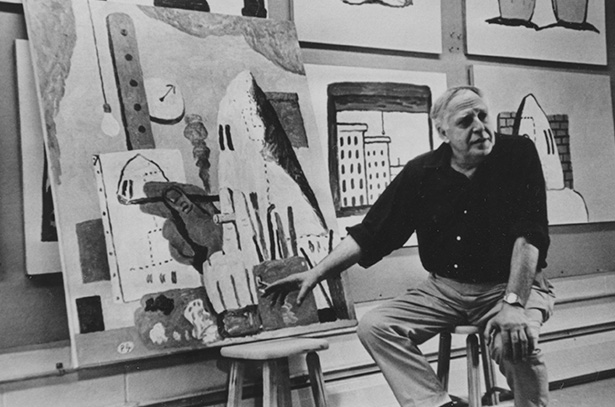One of the most influential artists of the last century, Philip Guston (1913 - 1980) is renowned globally for his art's profound personal introspection and keen societal awareness. This fall, Hauser & Wirth New York will explore Guston’s significant, yet often-overlooked, printmaking practice, filling a longstanding void in discussions of his work and its ongoing search for meaning.
Organized around three titular themes, ‘Room, Sea & Sky’ draws attention to the metamorphic qualities of Guston’s art through his printmaking. In the final year of his life, after a heart attack made work on large-scale paintings impossible, Guston turned to printmaking with a renewed focus. It was then that he began his collaboration with famed print workshop Gemini G.E.L. and its co-founders Sidney Felsen (1924 – 2024) and Stanley Grinstein (1927 – 2014), creating a series of major prints that brought his practice to its most mature form.

Room
1980

Interiors were among Guston’s favorite subjects, often conveying themes of confinement and isolation. His repeated creation of these images yielded a distinctly iterative artistic process, as evident in ‘Room’ (1980). Sharing the same title as a 1976 painting, this work depicts a chair piled high with a tangle of disembodied legs. Guston arranges the objects as in a still life, although he avoids any clear narrative, instead creating a sense of tension and entrapment. By tilting the picture plane towards the viewer, Guston infuses this abstracted but still recognizable jumble of objects with a sense of urgency, heightening the sense of immediacy and confinement.

This kind of anxious energy can also be felt in Guston’s renderings of the sky. The artist often used the sky as a backdrop for conflict, delving into its most evocative aspects in these late prints. Forms in works like ‘Aegean II’ (1977)––one of the two paintings on display in the exhibition––reappear in later prints such as ‘Sky’ (1980), where they are exploded, echoed and layered, as they become interconnected in their struggle against one another.

When Guston turns his focus to the sea, he depicts more subdued narratives of despair, but the conflicts are still evident. ‘Sea Group’ (1980) conveys a palpable tension, as if the forms might soon escape their confines. By contrast, ‘Sea,’ from the same year, with its group of heads floating in the placid water, offers a somewhat lighter, less angst-ridden image.

Possessing a physical presence that equals and at times rivals that of Guston’s large-scale paintings, these prints impact the viewer with a mastery of effect derived from decades of the artist pushing his artistic and psychological boundaries. Representing a unique détente between figuration and abstraction, the works on view in ‘Room, Sea & Sky’ represent the culmination of a lifetime of artistic daring.
About the Artist

Philip Guston
Philip Guston (1913 – 1980) is one of the great luminaries of twentieth-century art. His commitment to producing work from genuine emotion and lived experience ensures its enduring impact. Guston’s legendary career spanned a half century, from 1930 to 1980. His paintings—particularly the liberated and instinctual forms of his late work—continue to exert a powerful influence on younger generations of contemporary painters. For an in-depth overview of his career, click here.
Current Exhibitions
1 / 11
























